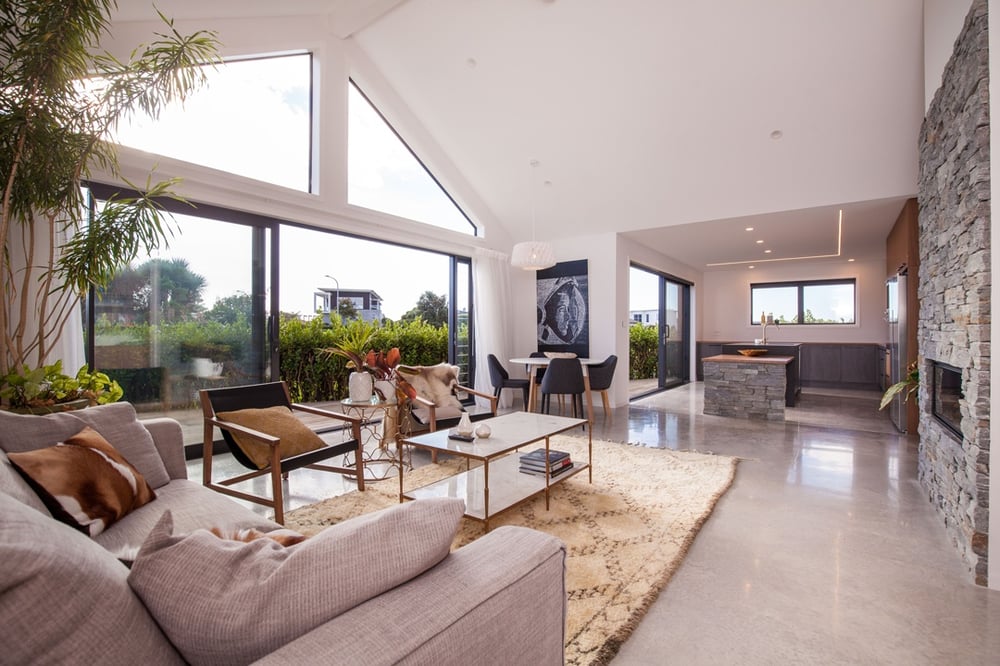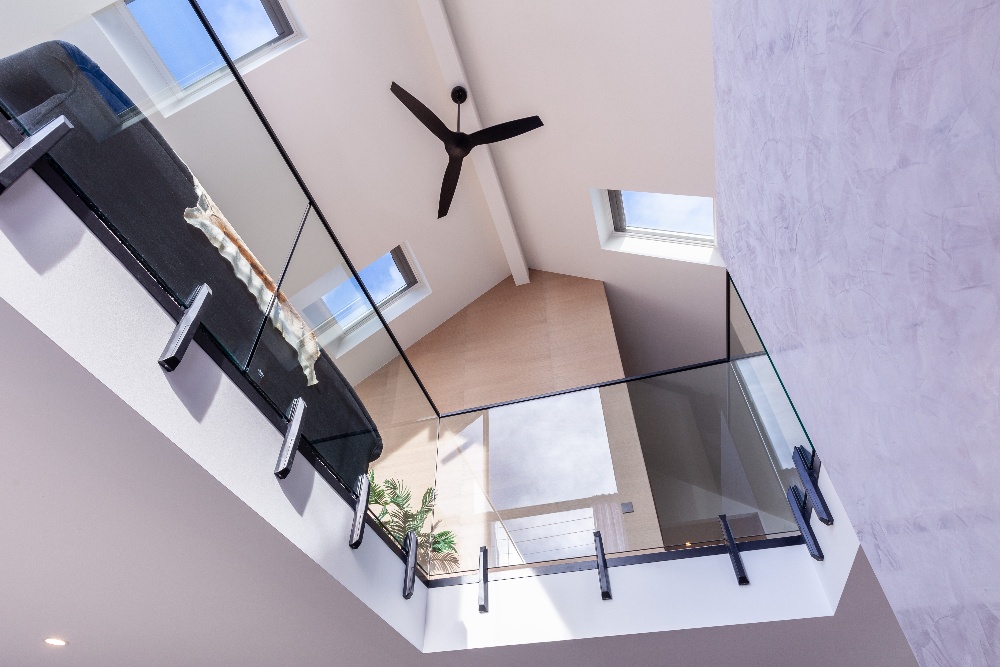Solutions when building a north-facing home isn't an option
North-facing homes have long been favoured for their even distribution of sunlight throughout the year. However, sometimes the property may have an amazing view that you don't want to miss, and building a north-facing home might not be an option.
But don't worry! Building a house with a different orientation doesn't mean you're missing out. In fact, other orientations can offer benefits that a northern angle won't capture. Depending on what you want to achieve, different orientations can work for you.
Benefits of a south-facing home
If maximising sunlight in your backyard is important, a south-facing home might be the perfect option for you. Although this orientation won't receive much direct sunlight in winter, it can be brightened up by generous window placement or skylights. Additionally, south-facing homes tend to be cooler in the summer, making them ideal for hot climates.
Benefits of a east-facing home
If you're a morning person, an east-facing house is perfect for capturing all the morning sun until noon and avoiding the heat of the afternoon. This orientation can make rooms uncomfortably hot in the morning during summer months, but in the winter months, all that sunlight pouring through the windows can be a beautiful way to start the day.
Benefits of a west-facing home
For those who enjoy brilliant sunset views, a west-facing home with a clear sightline to the horizon is a great option. The afternoon and evening hours of the west-facing home will be toasty in the winter, but they can get a bit warm in the summer.
Incorporating design elements for optimal light
Certainly, no house can provide direct sunlight throughout the entire day, but integrating specific design elements can assist in capturing, borrowing, and reflecting both warmth and light regardless of your home's orientation. Here are some options to contemplate when designing your new home build on your property.
Clerestory windows

Clerestory windows, also known as clearstory windows or high windows, are a design feature that involves placing a row of windows above eye level in a building. These windows are strategically positioned to allow natural light to enter the space, creating a well-lit and inviting atmosphere.
One of the main advantages of clerestory windows is their ability to harness ambient lighting throughout the day, regardless of the weather conditions. By positioning the windows higher up on the wall, they capture sunlight from a higher angle, maximising the amount of daylight that enters the room. This feature is particularly beneficial in areas where building orientation or obstructions limit the availability of direct sunlight.
The placement of clerestory windows allows natural light to penetrate deeper into the interior, reaching areas that would otherwise be overshadowed by walls or neighbouring structures. This creates a sense of openness and spaciousness, making the room feel brighter and more welcoming.
In addition to providing ample natural light, clerestory windows offer privacy advantages. Placed higher on the wall, they allow for light to enter while maintaining a level of privacy by preventing direct views from outside. This is especially useful in urban environments or locations where maintaining privacy is a concern.
Indoor courtyards
Indoor courtyards are architectural features that bring the outdoors inside by creating open-air spaces within the confines of a building. These courtyards are typically enclosed by walls or a glass roof, allowing them to be enjoyed year-round regardless of weather conditions. One of the key advantages of indoor courtyards is their ability to improve natural lighting throughout the entire house.
By introducing an open space within the interior of a building, indoor courtyards facilitate the penetration of natural light into areas that would otherwise be secluded from windows or direct sunlight. The design allows light to filter through the courtyard's open ceiling or skylights, creating a diffused illumination that spreads throughout the adjacent rooms and corridors.
The presence of an indoor courtyard can significantly enhance the overall lighting quality in a home. The abundant natural light that enters through the courtyard helps reduce the reliance on artificial lighting during the day, resulting in a more energy-efficient and sustainable living environment.
Apart from lighting benefits, indoor courtyards offer various other advantages. They can serve as private outdoor sanctuaries, providing a connection to nature and a refreshing environment for relaxation and contemplation. They can also act as natural ventilation shafts, promoting airflow and aiding in cooling the house during warmer months.
Skylights

Skylights consist of windows or transparent panels installed in the roof of a building. Their primary function is to bring natural light into interior spaces by allowing sunlight to enter from above. One of the remarkable advantages of skylights is their ability to provide diffused lighting, even in areas that are typically deprived of natural light.
Skylights can be strategically placed almost anywhere, allowing them to illuminate even the deepest recesses of a home. By positioning skylights in areas where direct sunlight is limited or obstructed, such as narrow hallways or interior rooms, they effectively bring in much-needed daylight.
The diffused lighting provided by skylights offers several benefits, such as reducing the reliance on artificial lighting during the day, leading to energy savings and a more sustainable living environment. Natural light has been shown to improve mood, productivity, and overall well-being, so incorporating skylights into a home can have positive effects on the occupants.
In addition to providing ample light, skylights can also offer views of the sky, adding a visual connection to the outdoors. This can enhance the overall ambiance of a space, create a sense of openness, and provide a feeling of being connected to nature.
Skylights come in various shapes, sizes, and designs to suit different architectural styles and preferences. They can be fixed or operable, allowing for ventilation and fresh air circulation in addition to natural light. Some skylights are equipped with shading or glazing options to control the amount of light and heat that enters the space.
Brighter wall paint and décor

Choosing a brighter wall paint and décor can have a transformative effect on the brightness and overall atmosphere of a room. By utilising light-coloured or reflective surfaces, this design approach maximises the amount of light in the space, creating a brighter and more inviting environment.
Opting for lighter wall paint colours, such as whites, creams, pastels, or soft neutrals, can significantly impact the perceived brightness of a room. Light-coloured walls reflect more light, helping to distribute it evenly throughout the space. This creates an illusion of openness and airiness, making the room appear larger and brighter than it actually is. Additionally, lighter wall colours can enhance the effect of natural and artificial lighting, amplifying its brightness and making the room feel more cheerful and welcoming.
In addition to wall paint, the choice of décor elements can further enhance the brightness of a room. Selecting furniture, textiles, and accessories in lighter shades or with reflective surfaces can contribute to the overall luminosity. For example, using mirrors strategically placed across from windows or light sources can bounce light around the room, effectively brightening it. Similarly, incorporating metallic accents, glass features, or glossy finishes on furniture or decorative items can help reflect and scatter light, enhancing the room's brightness.
At Location Homes, we stay up to date with the latest science, thinking, and technology to create healthy, sustainable homes. We'd be happy to answer your questions and consult with you on how you can achieve your dream home. Contact our team here to get started!
blog Categories:
-1%202.webp?width=299&height=151&name=Style%20Guide%20Download%20CTA%20(1000%20%C3%97%20600%20px)-1%202.webp)
LOOKING FOR INSPIRATION?
Our style guide is the ideal place to begin the search for your dream home. Featuring our most recent builds. Download your free copy.
.png?width=657&height=431&name=Untitled%20design%20(4).png)